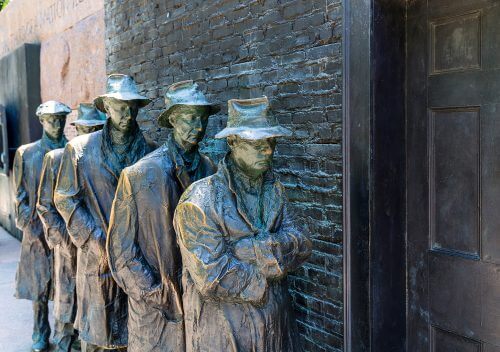American inequality researchers compare the opposite reactions of the administrations to the Great Depression and the crisis of 2008, and recommend adopting the principles of the New Deal
By: Ken-Ho Lin, Associate Professor of Sociology, The University of Texas at Austin, Megan Neely, Postdoctoral Researcher, Stanford University

The coronavirus continues to spread around the world, and it is quite clear that the global economy is entering a recession - the first since 2008. Some officials have compared the previous period of economic decline - also called the Great Recession - to the Great Depression that began in 1929. But it is clear that these two recessions differed not only in severity but also in the results they had in terms of inequality in the United States.
Although the depression was larger and longer than the recession, the decades after the depression greatly reduced the wealth of the rich and improved the financial security of many workers. Conversely, the recession worsened inequality in both income and wealth.
Some researchers have attributed this phenomenon to a weakened labor movement, fewer protection measures for workers and a radical political right. In our view, this explanation misses the dominance of Wall Street and the financial sector and ignores their fundamental role in creating economic differences. We are experts in income inequality, and in our new book "Divested: Inequality in the Age of Finance" we argue that inequality due to the recession has a lot to do with how the government planned its response.
the low
The reforms during the Great Depression changed the structure of the financial system by restricting banks from risky investments, Wall Street from betting on household savings, and lenders from charging high or unexpected interest rates.
The New Deal, a series of government programs created after the Great Depression, took a bottom-up approach and brought government resources directly to unemployed workers.
On the other hand, the regulatory policy since the financial crisis that started in 2008 was mainly aimed at restoring financial order that for decades channeled resources from the rest of the economy to the top.
In other words, the recent recovery has been largely focused on finance. Government incentives, especially massive infusions of credit, went first to banks and large companies, with the hope that the credit would eventually trickle down to needy families.
The conventional wisdom was that banks knew how to best use credit. Therefore, to stimulate economic growth, the Federal Reserve increased the money supply to banks by purchasing US government securities and mortgage backers.
But the incentive didn't work the way the government intended. The banks prioritized their interests over the public interest. Instead of lending the money to home buyers and small businesses at historically low interest rates, they deposited the funds and waited for interest rates to rise.
Similarly, companies did not use the easy credit to raise wages or create jobs. Instead they borrowed to buy their own shares and diverted the profit to senior executives and shareholders.
As a result, the principle of "banks and companies first" created a very uneven recovery.
Who lost in 2009?
The financial crisis wiped out nearly three-quarters of profits in the financial sector, but the sector fully recovered by mid-2009, as we wrote in the book.
His earnings continued to grow in the following years. In 2017 the sector earned 80% more than before the financial crisis. Profit growth was much slower in the non-financial sector.
Companies outside the financial sector were more profitable because they had fewer employees and lower wage costs. Payroll spending fell by 4% during the recession and remained low during the recovery.
The stock market fully recovered from the crisis in 2013, a year when the unemployment rate was as high as 8% and the rate of defaults on single-family homes was still above 10%.
Median household wealth, meanwhile, has not yet recovered from its plunge during the Great Recession.
The racial wealth gap has also only widened. The median wealth of all households fell by about 25% after the real estate bubble burst, but white households recovered at a much faster rate.
In 2016, the wealth of black households was about 30% less than before the avalanche, compared to 14% for white families.
When the government discusses a stimulus package, the officials can decide to continue the "trickle-down" approach to first protect the banks, companies and their investors through monetary incentives.
Or they can learn from the New Deal and bring government support directly to the weakest communities and families.
to the article on The Conversation website
More of the topic in Hayadan:
